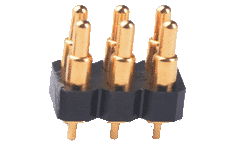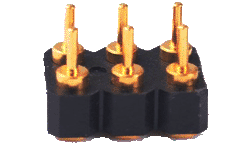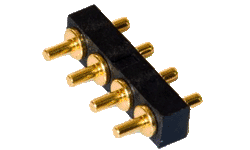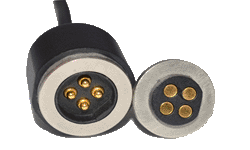
Pogo pins, also known as spring-loaded contacts, are widely used in a variety of electronic devices, especially in testing and connection applications. These pins consist of a conductive metal pin surrounded by a spring mechanism. They are designed to provide a temporary electrical connection between two surfaces, which allows for testing, communication, or data transmission in various circuits and systems.
However, there are instances where pogo pins fail to return to their original position after compression, which can be problematic in many electronic systems. This issue could arise from a variety of factors related to design, material selection, manufacturing quality, and environmental conditions. In this article, we will explore the potential causes of pogo pin failure to return to its original position and discuss solutions to mitigate or prevent these failures.
1. Spring Mechanism Failure
The primary reason for a pogo pin's inability to return to its original position is the failure of the spring mechanism. The spring inside the pogo pin is responsible for pushing the pin back to its resting position once it is compressed. There are several factors that could lead to spring failure:
-
Fatigue: The spring in a pogo pin undergoes repeated compression and decompression cycles. Over time, repeated cycling can cause the spring material to fatigue, resulting in a loss of spring force. Once the spring loses its elasticity, it may not be able to push the pin back to its original position. This can happen after a high number of actuation cycles or under extreme pressure.
-
Material Degradation: If the spring is made of low-quality materials or inappropriate alloys, it may degrade over time. Materials like stainless steel, which are commonly used in pogo pins, have certain limitations when it comes to stress resistance and fatigue. If the material used for the spring is prone to corrosion or weakening, it may fail to rebound.
-
Incorrect Spring Tension: If the spring tension is not calibrated properly during the manufacturing process, it may not provide sufficient force to push the pogo pin back to its resting position. This can be caused by manufacturing defects or errors in the selection of the spring's properties.
2. Overcompression of Pogo Pin
Another common cause for a pogo pin failing to return to its original position is overcompression. When a pogo pin is subjected to excessive force during use, the spring may be compressed beyond its designed limit, leading to permanent deformation or loss of elasticity. This overcompression can occur under the following circumstances:
-
Excessive Pressure: If the pin is pressed down with too much force, it may deform the spring or prevent it from fully returning to its original position. This can occur during testing procedures or when the pogo pin is not aligned correctly with the target surface.
-
Incorrect Alignment: Pogo pins are designed to make contact with a specific area on a target surface, but if the pin is misaligned, the force applied to the spring may not be evenly distributed. This can result in excessive pressure on the spring, which could lead to permanent deformation.
-
Temperature Effects: Changes in temperature can affect the spring’s properties. In high-temperature environments, the spring material may expand, leading to a higher level of compression than expected. If the temperature fluctuation is significant enough, it can cause the spring to lose its ability to return to its original position.
3. Manufacturing Defects
Pogo pins are precision components that require accurate manufacturing to ensure they function correctly. Even small defects during production can lead to problems in the pin’s performance, including failure to return to its original position. Some common manufacturing issues include:
-
Misaligned Springs: If the spring inside the pogo pin is not properly aligned with the conductive contact pin, it may not function as intended. Misalignment can prevent the spring from applying uniform pressure, causing it to lose its ability to push the pin back.
-
Defective Plating or Coating: Pogo pins are often plated with materials such as gold or nickel to improve conductivity and prevent corrosion. If the plating is uneven or defective, it can interfere with the pin’s movement, leading to the failure of the spring mechanism.
-
Incorrect Pin Length or Design: If the pogo pin's length is incorrectly designed or manufactured, the spring might not have the correct amount of tension to push the pin back after compression. Additionally, poorly designed pins may experience friction or binding inside their housing, which could prevent the pin from returning to its original position.
4. Environmental Factors
Environmental conditions can also play a significant role in the failure of pogo pins. Various factors such as moisture, dust, and temperature can impact the performance of pogo pins and cause them to malfunction.
-
Moisture and Corrosion: When pogo pins are exposed to moisture or high humidity, the metal parts of the pin and the spring may begin to corrode. Corrosion reduces the spring’s flexibility and may cause the pogo pin to stick in its compressed state. The degradation of materials due to moisture exposure can also weaken the overall structure of the pin.
-
Dust and Debris: Pogo pins are used in a wide range of environments, and they are often exposed to dirt, dust, and other contaminants. These particles can enter the pin housing and impede the movement of the pin. If debris collects around the spring, it can cause the spring to bind or become misaligned, preventing it from returning to its original position.
-
Extreme Temperature Variations: As mentioned earlier, temperature can significantly affect the material properties of the spring inside the pogo pin. In environments where temperatures fluctuate drastically, the spring may expand or contract in ways that alter its ability to return to its resting position. Additionally, extreme cold can cause the spring to become brittle, making it more prone to failure.
5. Improper Handling and Usage
Improper handling or usage of pogo pins can also lead to their failure to return to the original position. Some common mistakes in handling include:
-
Excessive Force During Compression: Applying too much force when pressing down on a pogo pin can lead to permanent deformation of the spring or the pin itself. This can occur if the pin is used in a system that applies excessive force or if the pin is not installed properly.
-
Incorrect Socket or Connector Design: The pogo pin may fail to return to its original position if it is used in a poorly designed socket or connector. If the socket is too tight or too loose, it may cause the pogo pin to be misaligned, leading to irregular compression and reduced spring action.
-
Repetitive Stress: In applications where pogo pins are used for high-frequency testing or repetitive connections, the constant cycling can lead to wear and tear. While this is expected to some degree, if the system is not designed to accommodate this stress, it can result in premature failure of the pogo pin.
Solutions and Mitigation
To prevent cnomax pogo pins from failing to return to their original position, several steps can be taken:
-
Quality Materials: Choose high-quality, corrosion-resistant materials for the spring and pin components. Materials like stainless steel, beryllium copper, or alloyed copper are preferred for their durability and fatigue resistance.
-
Proper Calibration: Ensure that the spring tension is properly calibrated during manufacturing and testing processes. This will help prevent underperformance due to low spring force.
-
Environmental Considerations: Ensure that the pogo pins are used in environments that minimize exposure to moisture, extreme temperatures, and excessive dust. Using sealed connectors or protective housings can help shield the pins from environmental damage.
-
Design Improvements: Consider improving the overall design of the pogo pin, such as using longer springs or adding additional cushioning mechanisms. Using high-quality plating on the contact surfaces can reduce wear and corrosion.
-
Regular Maintenance: For systems with high-frequency usage, regular maintenance and inspection of the pogo pins are essential. Checking for signs of wear, corrosion, or debris accumulation can help identify potential issues before they lead to failure.
Pogo pins are an essential component in many electronic systems, but they can fail to return to their original position due to a variety of factors. Issues with the spring mechanism, overcompression, manufacturing defects, environmental factors, and improper handling all contribute to this problem. Understanding the causes behind pogo pin failure and taking the necessary precautions can help improve the longevity and reliability of pogo pins in various applications. Proper material selection, design optimization, and environmental considerations are crucial in ensuring that pogo pins continue to function as intended.
more about pogo pin news : Pogo pin news





